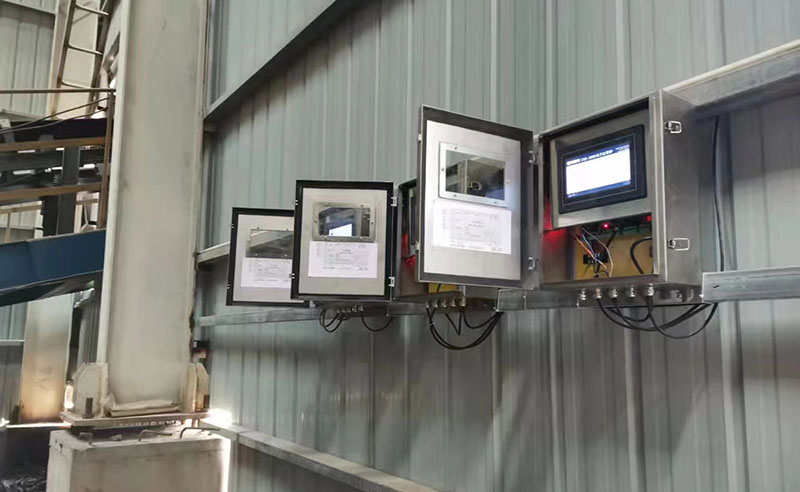
Four Development Trends in the Practical Application of Electronic Belt Scale Instruments
It is well known that electronic belt scales are metering devices used for continuous weighing of solid bulk materials during conveyor belt transportation. They are characterized by continuous and automatic weighing processes, high weighing efficiency, wide application, and increasingly high requirements for belt scales with rapid updates and iterations.
Electronic belt scales mainly consist of a scale frame, instrument, weight sensor, and speed sensor. Their development relies on the development of each component and the cooperation among them. Among these, the instrument is the core for data processing and display in the belt scale weighing system, with its performance and functions having a significant impact on the measurement and use of the belt scale. With the development and application of technologies such as the Internet of Things and computer information in belt scale systems, as well as the continuous upgrading of industrial metering needs, the performance requirements for electronic belt scale instruments are also becoming increasingly high. The development trends in practical applications mainly include richer functions, simpler panels, richer content display, and communication bus integration.

(1) Richer Functions
The application of computer technology in belt scale instruments has made the instruments microcomputerized, with calculation speeds and accuracy far surpassing previous belt scale instruments, and with richer and more intelligent functions. Modern belt scale instruments not only have the functions of receiving and processing weight signals and belt speed signals and displaying results, but also have more intelligent functions that improve measurement accuracy, stability, and ease of operation, including automatic zero adjustment, non-linear compensation of scale frame characteristics, environmental temperature compensation, digital filtering, simulation verification, weighing system monitoring, self-diagnosis, self-alarm, fault analysis and diagnosis, etc. It is worth mentioning that for feeders, the instruments also have functions such as PID control, customized control, and parameter setting. The richness of instrument functions is largely due to the increase of built-in sensors and the reliance on software technology.
(2) Simpler Panels
Modern electronic belt scale instruments have reduced overall dimensions, but the display and operation panels are larger, with more comprehensive and intuitive display content, fewer operation buttons, and greatly improved operability. For example, the Guonuo Technology electronic belt scale instrument features a 7-inch color LCD touchscreen display, with full Chinese and English menus and prompt functions, making it simple and convenient to operate without the need for specialized training for on-site personnel.
(3) Richer Content Display
The display content has shifted from simple accumulated quantity and instantaneous flow rate digital text displays to digital and visual graphic displays, with rich content, large storage capacity, and the ability to query historical data. The display colors have also evolved from black and white to color. For example, the pages, menus, system buttons, and display content of Guonuo Technology electronic belt scale instruments all use different colors for easy operation and viewing; the instruments adopt FLASH storage with large capacity, enabling data query based on multiple conditions.
(4) Communication Bus Integration
Enhanced communication function is an important hallmark of intelligent instruments. Through various networking methods, belt scales are no longer isolated information blocks, but are instead integrated for monitoring and remote control. Effective communication allows the instrument to upload belt scale measurement data and operational data to servers, providing data support for management decisions. For example, Guonuo Technology electronic belt scale instruments support the MODBUS standard communication protocol, enabling remote modification and control, as well as data upload to cloud platforms via the network.
In summary, the internal functions and performance of electronic belt scale instruments have become more "complex", while the aspects directly facing users, such as display and operation, have become increasingly simplified.
 Application of Quantitative Screw Feeder in the Powder-washed Salt Production Line
Application of Quantitative Screw Feeder in the Powder-washed Salt Production Line
 Automatic Weighing Equipment on Conveyor Belts: Electronic Belt Scales
Automatic Weighing Equipment on Conveyor Belts: Electronic Belt Scales
 Mine Electronic Belt Scale: Automatic Collection of Production Monitoring Data
Mine Electronic Belt Scale: Automatic Collection of Production Monitoring Data
 Automatic Weighing and Dosing Control System: Enhancing Economic Efficiency for Production Enterprises
Automatic Weighing and Dosing Control System: Enhancing Economic Efficiency for Production Enterprises
 Mine Explosion-Proof Belt Scale: A Competent Assistant for Weighing and Metering in the Coal Mining Industry
Mine Explosion-Proof Belt Scale: A Competent Assistant for Weighing and Metering in the Coal Mining Industry
 Belt Conveyor Automatic Weighing Device: Simplifying Industrial Production Processes and Enhancing Operational Efficiency
Belt Conveyor Automatic Weighing Device: Simplifying Industrial Production Processes and Enhancing Operational Efficiency
 Belt Conveyor Weighing and Metering System: Facilitating the Intelligentization of Industrial Bulk Material Metering
Belt Conveyor Weighing and Metering System: Facilitating the Intelligentization of Industrial Bulk Material Metering
 Electronic Belt Scale: A Continuous, Cumulative, Automatic, and Precise Dynamic Weighing System for Conveyor Belts
Electronic Belt Scale: A Continuous, Cumulative, Automatic, and Precise Dynamic Weighing System for Conveyor Belts
 Matrix-Type High-Precision Belt Scale Achieves Trade-Grade Measurement Accuracy
Matrix-Type High-Precision Belt Scale Achieves Trade-Grade Measurement Accuracy
